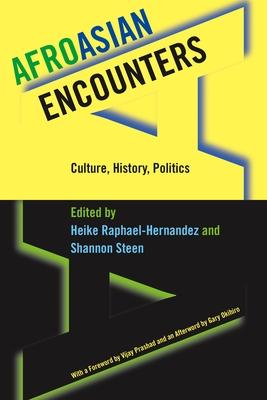With a Foreword by Vijay Prashad and an Afterword by Gary Okihiro
How might we understand yellowface performances by African Americans in 1930s swing adaptations of Gilbert and Sullivan's The Mikado, Paul Robeson's support of Asian and Asian American struggles, or the absorption of hip hop by Asian American youth culture?
AfroAsian Encounters is the first anthology to look at the mutual influence of and relationships between members of the African and Asian diasporas. While these two groups have often been thought of as occupying incommensurate, if not opposing, cultural and political positions, scholars from history, literature, media, and the visual arts here trace their interconnections and interactions, as well as the tensions between the two groups that sometimes arise. AfroAsian Encounters probes beyond popular culture to trace the historical lineage of these coalitions from the late nineteenth century to the present.
A foreword by Vijay Prashad sets the volume in the context of the Bandung conference half a century ago, and an afterword by Gary Okihiro charts the contours of a "Black Pacific." From the history of Japanese jazz composers to the current popularity of black/Asian "buddy films" like Rush Hour, AfroAsian Encounters is a groundbreaking intervention into studies of race and ethnicity and a crucial look at the shifting meaning of race in the twenty-first century.

Afroasian Encounters: Culture, History, Politics
With a Foreword by Vijay Prashad and an Afterword by Gary Okihiro
How might we understand yellowface performances by African Americans in 1930s swing adaptations of Gilbert and Sullivan's The Mikado, Paul Robeson's support of Asian and Asian American struggles, or the absorption of hip hop by Asian American youth culture?
AfroAsian Encounters is the first anthology to look at the mutual influence of and relationships between members of the African and Asian diasporas. While these two groups have often been thought of as occupying incommensurate, if not opposing, cultural and political positions, scholars from history, literature, media, and the visual arts here trace their interconnections and interactions, as well as the tensions between the two groups that sometimes arise. AfroAsian Encounters probes beyond popular culture to trace the historical lineage of these coalitions from the late nineteenth century to the present.
A foreword by Vijay Prashad sets the volume in the context of the Bandung conference half a century ago, and an afterword by Gary Okihiro charts the contours of a "Black Pacific." From the history of Japanese jazz composers to the current popularity of black/Asian "buddy films" like Rush Hour, AfroAsian Encounters is a groundbreaking intervention into studies of race and ethnicity and a crucial look at the shifting meaning of race in the twenty-first century.